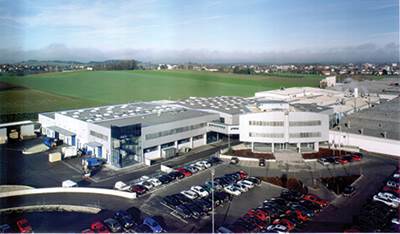FACC starts series production of bypass ducts for PW800 engines
FACC contributes innovative composite technology to the next generation of PurePower engines from Pratt & Whitney Canada.
FACC AG (Ried im Innkreis, Austria) recently received approval of the first article parts and go-ahead for series production of bypass ducts for the new PurePower PW814 and PW815 engines by Pratt & Whitney Canada, achieving an important program milestone. The Austrian aerospace industry supplier is contributing innovative composite technology to the new engine family, with responsibility for development and production of the bypass ducts.
In mid-November, after more than two years of development work, FACC delivered the first article parts to Pratt & Whitney Canada (P&WC, Longueuil, Quebec), where they were assembled with the engine. Following a successful test run and product release by P&WC, FACC is now commencing series production of the components at its Aerostructures plant in Reid. FACC's involvement in the PW800 program comprises deliveries throughout the service life of the engine family and a planned order volume of around US $150 million. "FACC ranks among the global market leaders in the design and production of bypass ducts – thanks above all to the longstanding close collaboration with Pratt & Whitney Canada," explains Walter Stephan, Chairman of FACC AG. "We are constantly seeking new solutions to make aircraft engines even better, stronger, safer and lighter. So we are all the more pleased that we can play a significant role in the next generation of engines for business jets."
Bypass ducts are structural components that shroud the outer airflow of jet engines. They must provide durability while simultaneously reducing noise and supporting very high loads in extreme flight situations, all with minimum weight.
Though bypass ducts were formerly made of metal, FACC began very early with the development of engine structures made from high-quality, lightweight composites. The company's years of design and production experience achieved real benefits for the PW800 program: FACC devised an efficient and economical production concept for manufacturing high-strength bypass ducts with low weight and optimum acoustics, but also excellent reliability and safety. Specialized production technologies, state-of-the-art automation and process optimization combined with a global supply chain have also achieved cost-effectiveness. FACC engine programs director Günter Nelböck stressed: "Thanks to innovative composite technologies, we achieve the necessary functionality with far fewer components. We need fewer rivets, screws, bolts, and subcomponents. Unnecessary interfaces are avoided and the number of individual working steps is lower. Consequently, our integral composite concepts are also a cost-effective solution."
In addition to the PW800 engines, FACC also supplies bypass ducts for other engine families made by P&W Canada and P&W USA, as well as components for various Rolls Royce engine families.
The new PurePower PW800 engine series is characterized by high fuel efficiency, lower emissions, and less engine noise. With 16,000 lb of thrust, it is specially designed for fast, long-haul business aircraft flying at high altitudes. Gulfstream Aerospace (Savannah, GA, US) relies on this first-class performance, selecting the PW814 and PW815 engines for its new, efficient Gulfstream G500 and G600 jets. Certification of these engines that will power the next generation of Gulfstream aircraft is expected before the end of 2014.
Related Content
Materials & Processes: Fibers for composites
The structural properties of composite materials are derived primarily from the fiber reinforcement. Fiber types, their manufacture, their uses and the end-market applications in which they find most use are described.
Read MoreMaterials & Processes: Resin matrices for composites
The matrix binds the fiber reinforcement, gives the composite component its shape and determines its surface quality. A composite matrix may be a polymer, ceramic, metal or carbon. Here’s a guide to selection.
Read MoreMaterials & Processes: Composites fibers and resins
Compared to legacy materials like steel, aluminum, iron and titanium, composites are still coming of age, and only just now are being better understood by design and manufacturing engineers. However, composites’ physical properties — combined with unbeatable light weight — make them undeniably attractive.
Read MoreCarbon fiber in pressure vessels for hydrogen
The emerging H2 economy drives tank development for aircraft, ships and gas transport.
Read MoreRead Next
FACC AG: Aerocomposites Powerhouse
This pragmatic Austria-based innovator is pursuing lofty goals in an aerocomposites future full of opportunity.
Read MoreFACC AG: Aerocomposites Powerhouse
This pragmatic Austria-based innovator is pursuing lofty goals in an aerocomposites future full of opportunity.
Read MoreFrom the CW Archives: The tale of the thermoplastic cryotank
In 2006, guest columnist Bob Hartunian related the story of his efforts two decades prior, while at McDonnell Douglas, to develop a thermoplastic composite crytank for hydrogen storage. He learned a lot of lessons.
Read More














.jpg;maxWidth=300;quality=90)








